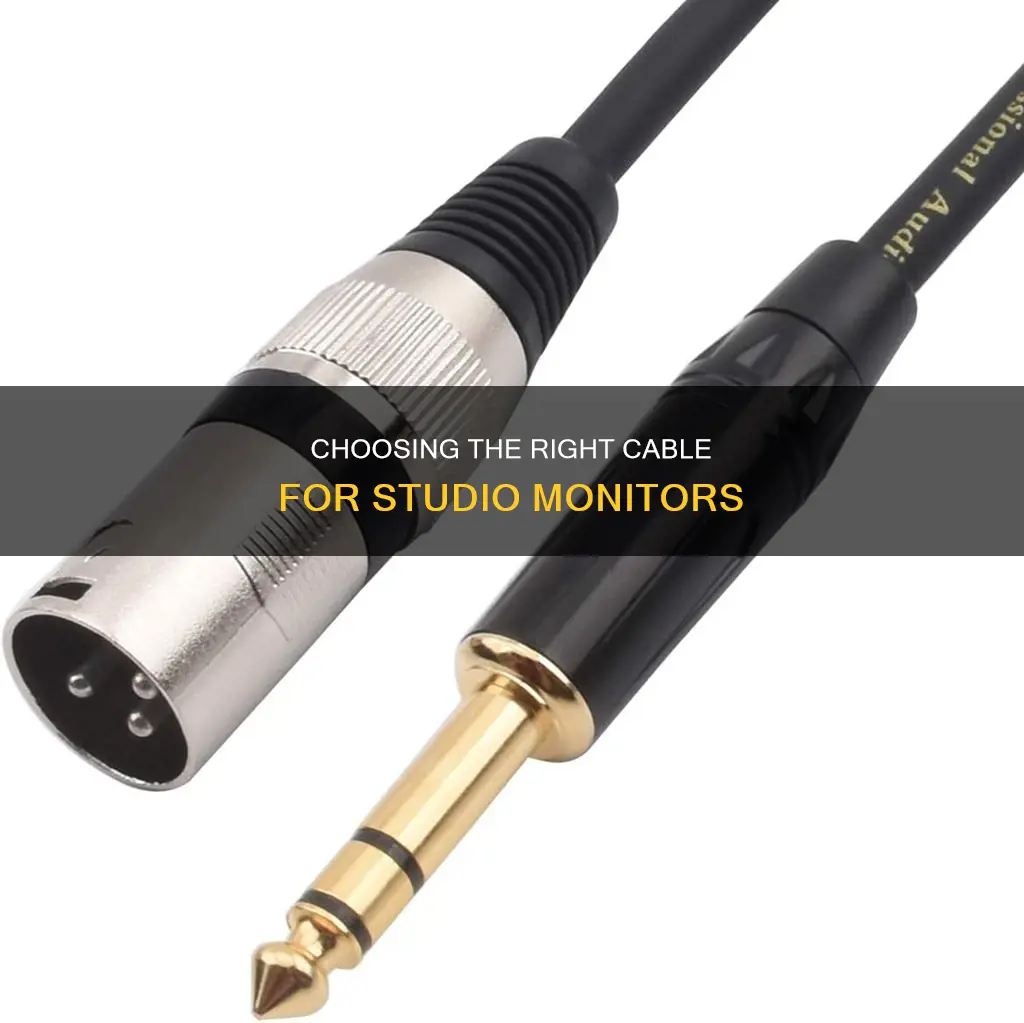
Studio monitors are a must-have for any recording engineer or audio enthusiast. But what cables do you need to connect your monitors to your audio interface or computer?
There are a few different types of cables that can be used for studio monitors, including XLR, TRS, and TS cables. XLR cables are typically used for microphones, but can also be used for studio monitors. They offer a stronger connection and better noise cancellation than other types of cables. TRS cables are also balanced and can be used for studio monitors, but are more commonly used for speakers. TS cables are unbalanced and are typically used for shorter connections, like those between a guitar and an amp.
When choosing studio monitor cables, it's important to consider the type of connectors you need, the length of the cables, and your budget. It's also important to use balanced cables whenever possible to reduce signal noise.
What You'll Learn

TRS vs. TS cables
When it comes to connecting studio monitors, it's important to understand the difference between TRS and TS cables. These terms refer to the type of connector on the cable, and each has its own specific use.
TRS stands for Tip, Ring, Sleeve, and it has three contact terminals. TRS cables are commonly used for stereo connections or balanced mono connections. In the context of studio monitors, you'll typically use a TRS cable to connect your speakers to your audio interface. This is because TRS cables provide a balanced connection, which means they have three wires inside, allowing for longer cable runs without introducing noise into the audio signal.
On the other hand, TS stands for Tip, Sleeve, and it only has two contact terminals. TS cables are typically used for mono, unbalanced signals and are commonly found in electric guitar applications. It's important to note that TS cables should not be used for connecting studio monitors, as they are not designed to handle the power requirements and could potentially damage your equipment.
When purchasing cables for your studio monitors, always opt for TRS cables to ensure a balanced and noise-free connection. Additionally, it's recommended to buy cables that are slightly longer than you need, as this gives you flexibility when setting up your studio.
In summary, TRS cables are the preferred choice for connecting studio monitors, as they provide a balanced stereo or mono connection. TS cables, on the other hand, are designed for different applications and should be avoided when connecting studio monitors to avoid potential issues.
Filmmakers: Calibrated Monitors Are Essential for Your Craft
You may want to see also

Balanced vs. unbalanced cables
Studio monitor speakers are a vital component of any home studio. They allow you to listen to your music clearly so that you can master your song effectively. However, the wrong cable can cause static electricity and other external stimuli to interfere with the signal coming through your monitor speakers.
Balanced Cables
Balanced cables are designed to eliminate noise and deliver sound with little to no interference, even at longer cable lengths. They achieve this through phase cancellation, where the main signal is carried over two conductors, with one at a lower amplitude. When the signals reach the speaker, they are joined together and don't cancel each other out because of the amplitude difference. Any interference is carried equally on all three conductors and is therefore cancelled out.
Balanced cables are also generally better quality and are a great upgrade to any studio. They are the best solution for reducing interference and are more reliable.
Unbalanced Cables
Unbalanced cables have only two conductors and can carry signals well at shorter distances. Over longer distances, or with the wrong equipment, they are more susceptible to picking up noise interference.
The ground wire in an unbalanced audio cable can act like an antenna, picking up unwanted noise as the audio signal travels through it. This is why unbalanced cables are best used for short distances, like connecting a guitar to a nearby amp.
If your speakers can take them, balanced cables are preferential for studio monitors as they reduce unwanted noise. Most studio monitor speakers can take a balanced cable.
However, if your monitor speakers only take unbalanced cables and you are not experiencing any problems with interference, then there is no reason to switch.
How to Tell the Difference
The easiest way to check if a cable is balanced or unbalanced is to look at the packaging or specifications when buying the cable. If you already own the cable, a 1/4-inch jack indicates an unbalanced cable if it has only one band. If it has two bands, it is a balanced cable, known as a Tip, Ring, Sleeve (TRS) connection.
XLR cables or microphone cables are also balanced cables.
Is Your Monitor Glossy? Here's How to Tell
You may want to see also

Cable length
When it comes to cable length, it's important to consider the distance between your studio monitors and your audio interface or computer. The length of the cable will depend on the setup of your studio space. While longer cables provide more flexibility in placement, they also introduce more variables that can affect sound quality.
Longer cables can pick up more signal noise and electromagnetic interference, degrading the audio signal. Additionally, longer cables can cause a slight delay in the audio signal, which may affect syncing. As a result, shorter cables are generally recommended to minimise these issues.
However, it's worth noting that modern cable technology has improved significantly, and many cables are designed to minimise interference and maintain signal integrity over longer distances. Oxygen-free copper, gold plating, and braided shielding are common features in modern cables that help reduce noise and improve durability.
When choosing the length of your studio monitor cables, it's best to opt for the shortest length that comfortably reaches your setup. This ensures optimal sound quality while providing enough flexibility for your studio arrangement.
Additionally, it's worth considering cable management solutions, such as cable ties or hooks, to neatly organise and secure your cables, preventing tangles and reducing the risk of damage.
Monitors for Graphic Design: Choosing the Perfect Display
You may want to see also

Cable connectors
When it comes to studio monitors, the cables you'll need will depend on the type of input jacks your speakers have. Most modern speakers have either a 1/4-inch TRS (Tip, Ring, Sleeve) jack or a female XLR input jack.
TRS cables are balanced, which means they have three wires inside the cable: two signal wires and one ground wire. This design helps to reduce unwanted noise in the audio signal. XLR cables are also balanced and have the same noise-cancelling benefits as TRS cables.
If your studio monitors have a 1/4-inch TRS jack, you'll need a TRS to TRS cable to connect them to your audio interface. If your monitors have an XLR input jack, you'll need an XLR to XLR cable.
It's important to note that you should avoid using unbalanced cables such as TS (Tip, Sleeve) cables, as these can introduce noise into your system.
- Cable Matters XLR to XLR: Designed with oxygen-free copper and a soft PVC jacket. Available in lengths up to 20 feet.
- Hosa CSS-110 TRS to TRS: Features balanced wiring to reduce electronic interference. Available in lengths up to 25 feet.
- Monoprice TRS to XLR: Offers a separate braided shield for extra noise reduction. Available in lengths up to 50 feet.
- Cable Matters TRS to XLR: Gold-plated connectors housed in a PVC jacket for durability. Available in lengths up to 50 feet.
- LinkinPerk TRS to TRS: Features 24k gold-plated connectors and a double-nylon braid housing. Available in lengths up to 15 feet.
- Seismic Audio TRS to TRS: Available in various colour combinations for easy identification and organisation.
Measuring Your Monitor: A Step-by-Step Guide to Sizing
You may want to see also

Cable brands
When it comes to choosing the right cable brand for studio monitors, there are several reputable options available in the market. Here are four to six paragraphs with detailed information about some popular and reliable cable brands:
Monoprice
Monoprice is a well-known brand that offers a range of high-quality audio cables, including TRS and XLR cables. Their Premier Series cables are highly recommended, featuring 16AWG wiring that helps reduce interference and ensures clear sound reproduction. Monoprice cables are available in various lengths, making them suitable for different studio setups. The brand is also praised for its affordable pricing compared to similar products.
Cable Matters
Cable Matters provides a diverse selection of studio monitor cables, including XLR-to-XLR, TRS-to-XLR, and TRS-to-TRS options. Their cables are designed with oxygen-free copper and feature gold-plated contacts, reducing oxidation and prolonging their lifespan. Cable Matters offers cables in different lengths, with some models reaching up to 50'. Their products are known for their durability and clear audio transmission.
Hosa
Hosa is a trusted brand in the audio industry, offering a range of studio monitor cables such as the CSS-110 TRS-to-TRS and CPP-201 Dual 1/4" TS-to-TS cables. Their products are designed to minimise electromagnetic interference and provide clear audio connections. Hosa cables are available in various lengths, with some models offering up to 25' options. The brand is known for its lightweight yet durable construction, making storage and transportation convenient.
EBXYA
EBXYA specialises in TRS-to-XLR cables, which are ideal for connecting mixer consoles and studio monitors. Their cables feature a zinc alloy XLR connector, providing enhanced durability and secure connections. EBXYA cables are double-shielded, effectively reducing interference and ensuring faithful sound reproduction. The brand also offers additional male/female configurations and oxygen-free copper wiring.
Seismic Audio
Seismic Audio offers a range of TRS-to-TRS cables, perfect for patch bays and studio monitor connections. One of their standout features is the availability of various colour combinations, making cable management and identification easier. Their cables are designed with balanced wiring to minimise interference and flexible rubber jacketing for durability. While Seismic Audio cables only come in a 6' length, they are an excellent choice for smaller studios.
Tisino
Tisino provides a selection of RCA-to-XLR and TRS cables, ideal for connecting studio monitors and audio gear. Their cables are designed with 20AWG 4N oxygen-free copper, reducing unwanted signal noise and improving audio clarity. tisino cables feature gold-plated connections and flexible nylon braiding to prevent tangles. While their unique colour scheme may take some time to get used to, tisino cables deliver faithful sound reproduction.
Best Places to Buy Sound Monitoring Machines
You may want to see also
Frequently asked questions
The different types of cables for studio monitors include XLR, TRS, and TS.
XLR cables have three pins and TRS cables have an extra ring, whereas TS cables only have one ring. XLR and TRS cables are balanced, meaning they have two signal wires and one ground wire, whereas TS cables are unbalanced and only have two wires.
You should consider your budget, the type of connectors you need, the length of the cables, and whether you need balanced or unbalanced cables.
XLR cables provide a stronger connection and reduce unwanted noise and interference, resulting in clearer audio.







